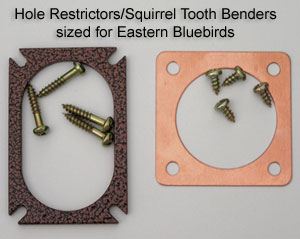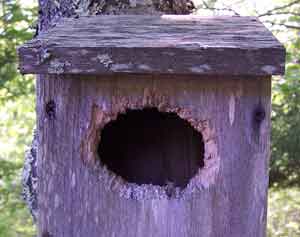
Hole restrictors (also called Hole Reducers, “Squirrel Tooth Benders,” Portals or Hole Guards) are used on nestboxes for five purposes:
- to keep critters like squirrels or woodpeckers from enlarging holes (or to return enlarged holes to the correct size), and to avoid allowing access to predators or nestbox occupants like Red Squirrels or non-native Starlings.
- to protect smaller birds like titmice or more timid small birds chickadees from losing their nests to more aggressive native birds, including Eastern Bluebirds and Tree Swallows. (See Competition)
- to keep aggressive non-native House Sparrows (HOSP) from entering the box of a smaller bird like a chickadee and attacking adults, eggs or nestlings
- to prevent the larger bluebird from entering a trap box being used to trap House Sparrows.
- to prevent a second premature fledging after young jump out and are returned to the box.
- A thick wooden block over the entrance hole may make it harder for avian predators like starlings and magpies to reach in and snag eggs/nestlings.
Where to get them: You can make your own by cutting up a plastic milk jug. If you are using metal, it might be easier to buy them, as they are hard to make at home unless you have the right tools. (They can be purchased at birding stores, or see list of suppliers). If you do make them yourself (e.g., out of copper or aluminum), be sure to file the edges to protect birds going through the hole. You can also use metal tacks around the hole. Plexiglas doesn’t work well because it’s hard to cut and the edges are too sharp. Lexan would be better, but may interfere with adult parents clinging to the outside of the hole to feed.DIY: If you have a 1.5″ hole saw for the entry hole and a 3″ hole saw for the outside diameter, you can make your own out of a sheet of plastic or an old plastic barrel, and then screw it on to the outside of the hole (larger hole for Mountain Bluebirds!)Size: Make sure the entry size is exact for the species you want to protect. (The photos above show portals sized for Eastern/Western Bluebirds at 1.5″ [round] or Peterson box ovals at 1.375″ x 2.250″). Mountain bluebirds need a 1 and 9/16″ hole.For Titmice, Carolina Wrens, or

Chickadees, all of which are less tolerant of monitoring than bluebirds, I usually put a restrictor on after the first egg is laid, to avoid scaring the parents off. At this point, the birds are more “committed” to the box.
I would also suggest that, if possible, you put a metal restrictor on the inside of the box, so the bird doesn’t see any change on the outside. (Just make sure you don’t drop a screwdriver on the eggs!)
HOSP: A hole restrictor can not be used to keep a HOSP out of a bluebird nest, because HOSP are smaller than bluebirds. In order to keep HOSP out, the hole must be smaller than 1.25″, which is only suitable for small birds like Titmice, chickadees and House Wrens. See nestbox specifications (by bird species) and hole sizes that exclude HOSP.
Birds (including HOSP) may initially be more attracted to boxes with larger holes. This may be because it facilitates speedy access for nest building and feeding, and reduces wear and tear on feathers. Some people have boxes that that 1.25″ or 1 1/8″ restrictors on them year round that go unused even by smaller birds like Chickadees and Titmice if birds are given a choice (e.g., 1.5″ hole).
If HOSP are pestering nestlings that are about to fledge, a 1 1/8″ hole restrictor may be used with care. The adult bluebirds will not be able to enter the box to brood (critical when nestlings are young), feed or remove fecal sacs. However, if the nestlings are old enough to come to the entrance hole, the parents will be able to dip their heads in to feed. The hole guard needs to be removed for fledging. I would rather use a sparrow spooker in this case.
Preventing Another Attempt at Premature Fledging: A hole restrictor can also used when older bluebirds (e.g., 13 days plus) have prematurely fledged and are returned to the box, to prevent them from jumping out again. The hole guard needs to be removed for fledging.
Wooden hole “face guards” – You can make these out of a block of wood (1 1/2 to 2 1/4″ thick). These will have to be replaced periodically if they get chewed through. The thickness may help prevent large predatory birds like starlings, magpies, crows or blue jays from reaching in and stealing eggs or nestlings. They are usually not sufficient to prevent the dexterous raccoon from raiding a nestbox. They may attract House Sparrows, and MAY deter Tree Swallows somewhat.
More Information:
- Hole Reducer Suppliers
- Predator Identification and Solutions
- Nestbox Specifications (by species)
- Hole Size Tests
- Hole size debate – starlings
- Predator baffles
- House Sparrow Control – including hole size dimensions to exclude HOSP
- When House Sparrows Attack (warning, graphic photos)
- Preventing Premature Fledging
Cease to violate the laws of nature, and of nature’s God, by the destruction of these his creatures, and by every available means afford them protection, and promote their comfort and consequent multiplication.
– R. Michener, Agricultural Ornithology, 1863
